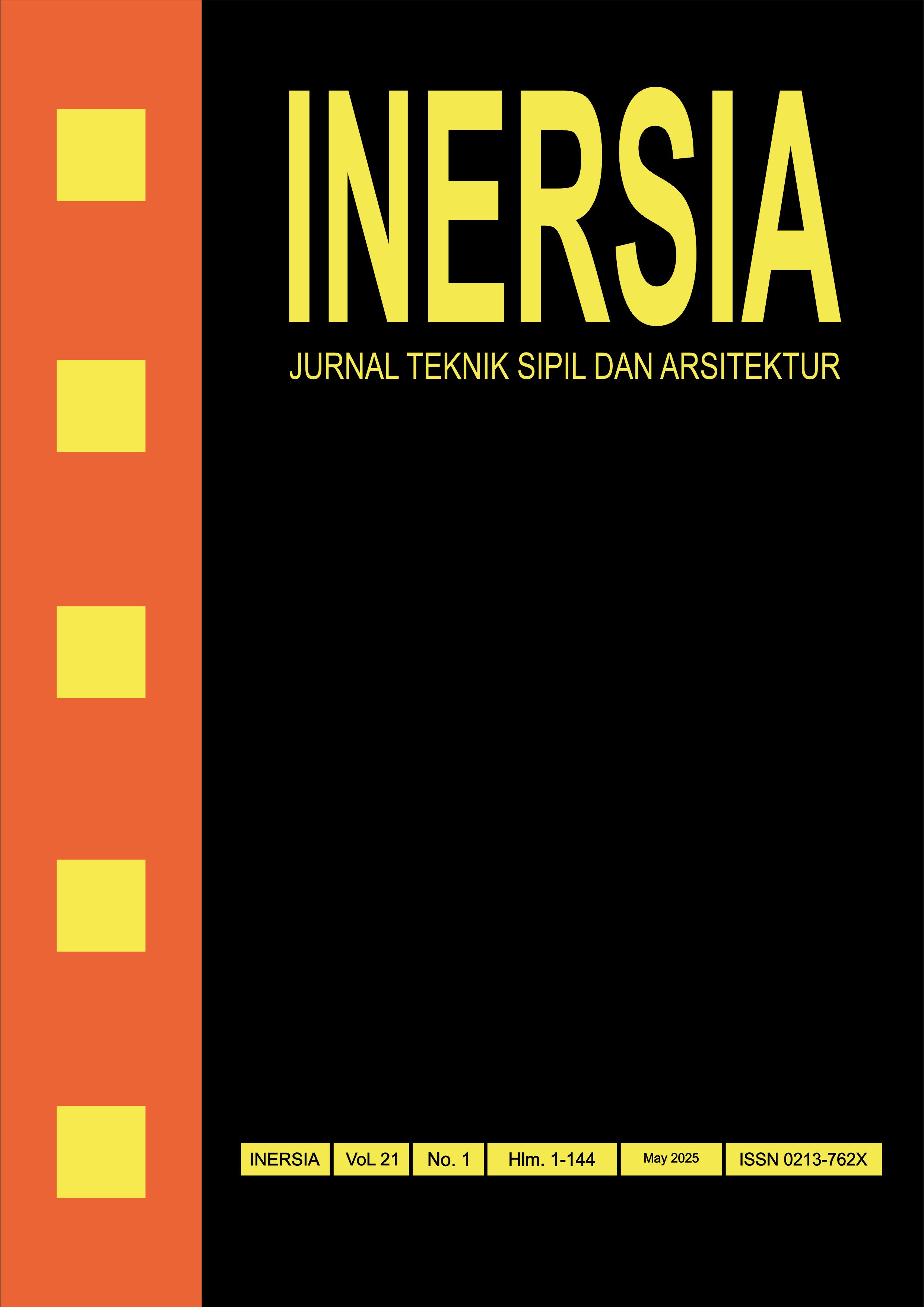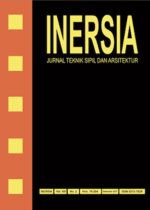Assessment Probability of Soil Liquefaction Potential Based on SPT Data with NovoLIQ Application
DOI:
https://doi.org/10.21831/inersia.v21i1.78664Keywords:
Cone Penetration Test, Liquifaction, Safety FactorAbstract
Liquefaction is a geological phenomenon that occurs when soil loses its strength due to a shock, such as an earthquake, and becomes semi-liquid. Liquefaction usually occurs in water-saturated sandy soils that are subjected to seismic stress. During an earthquake, the pore water pressure in the soil increases, causing the soil grains to lose contact with each other and resulting in the soil becoming unstable and behaving like a liquid. This process can have serious impacts on building structures and the infrastructure above them, such as foundation shifts, building tilting, and structural collapse. The Kulonprogo area is one of the areas that has a variety of soil types ranging from silt to sandy with a shallow groundwater table and is one of areas that according to BMKG, the Kulonprogo area is included in the area that has the potential to be affected by megathrust. Seeing from this, the Kulonprogo area has a high liquefaction potential. Based on this, this research will calculate the liquefaction potential in the Kulonprogo area using soil Cone Penetration Test data. Cone Penetration Test testing is carried out to a depth of 30 meters to evaluate the characteristics of soil layers and obtain N-SPT values that reflect the density and strength of the soil in each layer. The results of SPT testing at depths of up to 30 meters show a variety of soil types ranging from low plasticity silt in the upper layers to sand. The results obtained obtained the CRR value on average at each depth is 0.4 with SF between 1.04-1.68 which has a Liquefaction potential according to Youd and Nobel's theory of 80.2% and according to Centin's theory of 100%. This makes the Kulonprogo area have a high potential for Liquefaction, especially if a megathrust earthquake occurs.
References
[1] M. F. Alfaqikh and R. Zayadi, “Analysis Of Liquefaction Potential Based on SPT and CPT Data (Case Study: Binjeita, North Sulawesi),” Pros. Semin. Intelekt. Muda #7, pp. 82–87, 2022.
[2] A. Rahayu, I. Uno, N. Hidayat, A. Dwijaka, and M. Yusuf, “Potential of Liquifaction at Nasanapura Hospital Petobo Village Palu City,” IOP Conf. Ser. Earth Environ. Sci., vol. 1075, no. 1, 2022, doi: 10.1088/1755-1315/1075/1/012028.
[3] O. Uyanık, “Soil liquefaction analysis based on soil and earthquake parameters,” J. Appl. Geophys., vol. 176, 2020, doi: 10.1016/j.jappgeo.2020.104004.
[4] M. Akhila, K. Rangaswamy, and N. Sankar, “Liquefaction susceptibility of central Kerala,” SN Appl. Sci., vol. 1, no. 6, pp. 1–23, 2019, doi: 10.1007/s42452-019-0576-3.
[5] M. S. Hossain et al., “Assessment of soil liquefaction potential: a case study for Moulvibazar town, Sylhet, Bangladesh,” SN Appl. Sci., vol. 2, no. 4, pp. 1–12, 2020, doi: 10.1007/s42452-020-2582-x.
[6] N. Ntritsos and M. Cubrinovski, “A CPT-based effective stress analysis procedure for liquefaction assessment,” Soil Dyn. Earthq. Eng., vol. 131, no. October 2019, p. 106063, 2020, doi: 10.1016/j.soildyn.2020.106063.
[7] H. C. Hardiyatmo, Rekayasa Gempa untuk Analisis Struktur dan Geoteknik, 2nd ed. Yogyakarta (ID): Gadjah Mada University Press, 2024.
[8] M. H. Baziar and M. Alibolandi, “Assessment of liquefaction potential based on shear wave velocity: Strain energy approach,” J. Rock Mech. Geotech. Eng., vol. 16, no. 9, pp. 3733–3745, 2024, doi: 10.1016/j.jrmge.2023.10.021.
[9] A. Salimah, M. Z. Alvaro, W. A. Prakoso, Yelvi, D. S. Harminto, and W. Rahayu, “Experimental analysis of liquefaction potential with variations of soil relative density and earthquake frequency,” IOP Conf. Ser. Earth Environ. Sci., vol. 1266, no. 1, 2023, doi: 10.1088/1755-1315/1266/1/012063.
[10] B. M. Habibullah, R. M. Pokhrel, J. Kuwano, and S. Tachibana, “GIS-based soil liquefaction hazard zonation due to earthquake using geotechnical data,” Int. J. GEOMATE, vol. 2, no. 1, pp. 154–160, 2012, doi: 10.21660/2012.3.3p.
[11] V. Pratama, H. C. Hardiyatmo, and A. Saputra, “Liquefaction Potential in Waterfront Area of Labuan Bajo Based on Earthquake Return Period,” Int. J. GEOMATE, vol. 25, no. 111, pp. 104–112, 2023, doi: 10.21660/2023.111.4019.
[12] S. Ahmad, M. Z. Khan, A. Anwar, S. Mohd, and H. Ashraf, “Determination of Liquefaction Potential By Sub-Surface Exploration Using Standard Penetration Test,” IJISET-International J. Innov. Sci. Eng. Technol., vol. 2, no. 10, pp. 751–760, 2015, [Online]. Available: www.ijiset.com.
[13] Kusmanto, S. Ismanti, and A. F. Setiawan, “Assessment of Liquefaction Risk With Unidentified Seismic Parameters for Newly-Discovered Faults: Numerical Analysis,” Int. J. GEOMATE, vol. 26, no. 114, pp. 50–59, 2024, doi: 10.21660/2024.114.4192.
[14] A. Setyobudianto, F. Faris, and H. C. Hardiyatmo, “Study of Liquefaction Potential in Toll Road Construction on Fine-Grained Soil,” Int. J. GEOMATE, vol. 25, no. 112, pp. 64–74, 2023, doi: 10.21660/2023.112.4075.
[15] S. P. Naik, O. Gwon, K. Park, and Y. S. Kim, “Land damage mapping and liquefaction potential analysis of soils from the epicentral region of 2017 Pohang Mw 5.4 earthquake, South Korea,” Sustain., vol. 12, no. 3, 2020, doi: 10.3390/su12031234.
[16] S. Sadek, S. Najjar, Y. Mostapha, and M. Mostapha, “Assessment of the Potential for Earthquake-Induced Liquefaction in Granular Soils,” Spreadsheets Educ., vol. 7, no. 2, 2014.
[17] L. Minarelli et al., Liquefied sites of the 2012 Emilia earthquake: a comprehensive database of the geological and geotechnical features (Quaternary alluvial Po plain, Italy), vol. 20, no. 8. Springer Netherlands, 2022.
[18] B. W. Maurer, R. A. Green, M. Cubrinovski, and B. A. Bradley, “Evaluation of the Liquefaction Potential Index for Assessing Liquefaction Hazard in Christchurch, New Zealand,” J. Geotech. Geoenvironmental Eng., vol. 140, no. 7, pp. 1–11, 2014, doi: 10.1061/(asce)gt.1943-5606.0001117.
[19] A. R. Prasetya, F. Faris, and A. P. Rahardjo, “Seismic Vulnerability Assessment Using the Hvsr Method At Yogyakarta International Airport Underpass, Indonesia,” Int. J. GEOMATE, vol. 26, no. 114, pp. 25–33, 2024, doi: 10.21660/2024.114.4082.
[20] M. Ilham and D. P. E. Putra, “Integrated mapping of the earthquake-induced liquefaction in Wates Groundwater Basin, Kulon Progo for land use planning consideration: A preliminary study,” IOP Conf. Ser. Earth Environ. Sci., vol. 1071, no. 1, 2022, doi: 10.1088/1755-1315/1071/1/012005.
[21] M. A. Rahman, T. F. Fathani, A. Rifa’i, and M. S. Hidayat, “Analisis Tingkat Potensi Likuifaksi Di Kawasan Underpass Yogyakarta International Airpor,” J. Rekayasa Sipil, vol. 16, no. 2, p. 91, 2020, doi: 10.25077/jrs.16.2.91-104.2020.
[22] J. Facciorusso, C. Madiai, and G. Vannucchi, “CPT-Based Liquefaction Case History from the 2012 Emilia Earthquake in Italy,” J. Geotech. Geoenvironmental Eng., vol. 141, no. 12, pp. 1–17, 2015, doi: 10.1061/(asce)gt.1943-5606.0001349.
[23] R. E. Moss, R. B. Seed, R. E. Kayen, J. P. Stewart, A. Der Kiureghian, and K. O. Cetin, “CPT-Based Probabilistic and Deterministic Assessment of In Situ Seismic Soil Liquefaction Potential,” J. Geotech. Geoenvironmental Eng., vol. 132, no. 8, pp. 1032–1051, 2006, doi: 10.1061/(asce)1090-0241(2006)132:8(1032).
[24] F. Kamel and S. Badreddine, “Probabilistic Liquefaction Analysis Using Standard Penetration Test,” Stud. Geotech. Mech., vol. 44, no. 2, pp. 162–174, 2022, doi: 10.2478/sgem-2022-0009.
[25] M. Goharzay, A. Noorzad, A. M. Ardakani, and M. Jalal, “A worldwide SPT-based soil liquefaction triggering analysis utilizing gene expression programming and Bayesian probabilistic method,” J. Rock Mech. Geotech. Eng., vol. 9, no. 4, pp. 683–693, 2017, doi: 10.1016/j.jrmge.2017.03.011.
[26] A. Maksymowicz et al., “Coseismic seafloor deformation in the trench region during the Mw8.8 Maule megathrust earthquake,” Sci. Rep., vol. 7, no. March, pp. 1–8, 2017, doi: 10.1038/srep45918.
[27] B. Derode, R. Madariaga, and J. Campos, “Seismic rate variations prior to the 2010 Maule, Chile MW 8.8 giant megathrust earthquake,” Sci. Rep., vol. 11, no. 1, pp. 1–9, 2021, doi: 10.1038/s41598-021-82152-0.
[28] K. Filali and B. Sbartai, “A comparative study between simplified and nonlinear dynamic methods for estimating liquefaction potential,” J. Rock Mech. Geotech. Eng., vol. 9, no. 5, pp. 955–966, 2017, doi: 10.1016/j.jrmge.2017.05.008.
[29] T. L. Youd and I. M. Idriss, “Liquefaction criteria based on statistical and probabilistic analyses,” Tech. Rep. NCEER-97-0022, p. 281, 1997.
[30] K. O. Cetin et al., “SPT-based probabilistic and deterministic assessment of seismic soil liquefaction triggering hazard,” Soil Dyn. Earthq. Eng., vol. 115, no. July 2017, pp. 698–709, 2018, doi: 10.1016/j.soildyn.2018.09.012.
[31] V. S. Pillai and P. M. Byrne, “Effect of overburden pressure on liquefaction resistance of sand,” Can. Geotech. J., vol. 31, no. 1, pp. 53–60, 1994, doi: 10.1139/t94-006.
[32] T. Abdoun, “Evaluating the Impact of Overburden Pressure on Liquefaction Susceptibility in Granular Soils : Insights from Centrifuge Modeling,” vol. 0, no. October, pp. 1–7, 2024.
[33] Z. Li et al., “Study on the Effect of Liquefiable Overburden Foundations of Rockfill Dams Based on a Pore Pressure Model,” Water (Switzerland), vol. 16, no. 18, 2024, doi: 10.3390/w16182649.
[34] A. Pokhrel, G. Chiaro, T. Kiyota, and M. Cubrinovski, “Liquefaction characteristics of sand-gravel mixtures: Experimental observations and its assessment based on intergranular state concept,” Soils Found., vol. 64, no. 2, p. 101444, 2024, doi: 10.1016/j.sandf.2024.101444.
Downloads
Published
How to Cite
Issue
Section
License
Copyright (c) 2025 Pradyta Galuh Oktafiani, Nur Alfian Sasmayaputra

This work is licensed under a Creative Commons Attribution 4.0 International License.
Authors who publish with INERSIA journal agree to the following terms:
- Authors retain copyright and grant the INERSIA journal right of first publication with the work simultaneously licensed under Creative Commons Attribution License (CC BY 4.0) that allows others to share the work with an acknowledgment of the work's authorship and initial publication in this journal.
- Authors can enter into separate, additional contractual arrangements for the non-exclusive distribution of the published version of the work (e.g., post it to an institutional repository or edit it in a book), with an acknowledgment of its initial publication in this journal.
- Authors are permitted and encouraged to post their work online (e.g., in institutional repositories or on their website) before and during the submission process, as it can lead to productive exchanges, as well as earlier and greater citation of published work.

INERSIA by https://journal.uny.ac.id/index.php/inersia was distributed under a Creative Commons Attribution 4.0 International License











